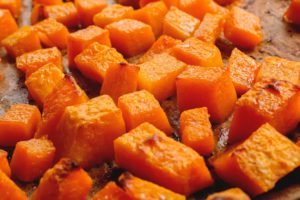Winter Squashes Galore
December 16, 2019
Besides fall foliage, one of the best things about this time of year is that it’s peak winter squash season. Though these squashes are available year-round, they are the star of the show now, and I am always thrilled when it’s their time to shine.
 Butternut Squash
Butternut Squash
Though it takes a bit of effort to prepare (peeling an awkward shape, scooping out seeds, cutting), it is well worth it. This funny-looking squash is full of phytonutrients, fiber, and vitamins A, C, E, and B. The vibrant orange flesh signals how rich it is in carotenoids, important for eye health. Roasting this squash caramelizes it and brings out its natural sweetness. I love roasting it with dried rosemary, and sometimes will switch it up and use za’atar which also pairs nicely.
 Acorn Squash
Acorn Squash
True to its name, acorn squash looks like a green oversized acorn. Inside that green exterior, though, is a vibrant yellow-orange flesh that, while it’s hard to cut through, softens beautifully once it hits the oven. Like butternut squash, it’s full of beneficial vitamins to keep your immune system strong, and has plenty of fiber for good digestive health. As far as eating this squash goes, one of my favorite things about acorn squash is its size; you can cut the squash in half, scoop out the flesh, and have 2 perfectly-sized halves for a dinner for two that can be filled with the stuffing of your choice (I often go for a wild-rice mixture). If you don’t want a stuffed acorn squash, you can cut it into thinner rings and roast them, maximizing the caramelization with more surface area directly against the pan.
 Spaghetti Squash
Spaghetti Squash
Spaghetti squash is the original “alternative pasta,” before zoodles and chickpea/cauliflower/lentil pasta became trendy. This squash’s unique stringy texture lends itself perfectly to spaghetti-like vegetable-based dishes. All you need to do is cut the squash in half length-wise, scoop out the seeds, and roast it for 30-45 minutes until the flesh is tender. At that point, you can take a fork and (carefully!) scoop out the spaghetti-like squash. From there, you can toss it in sauce as you would your typical spaghetti! This squash has similar nutrient benefits as the aforementioned two.





